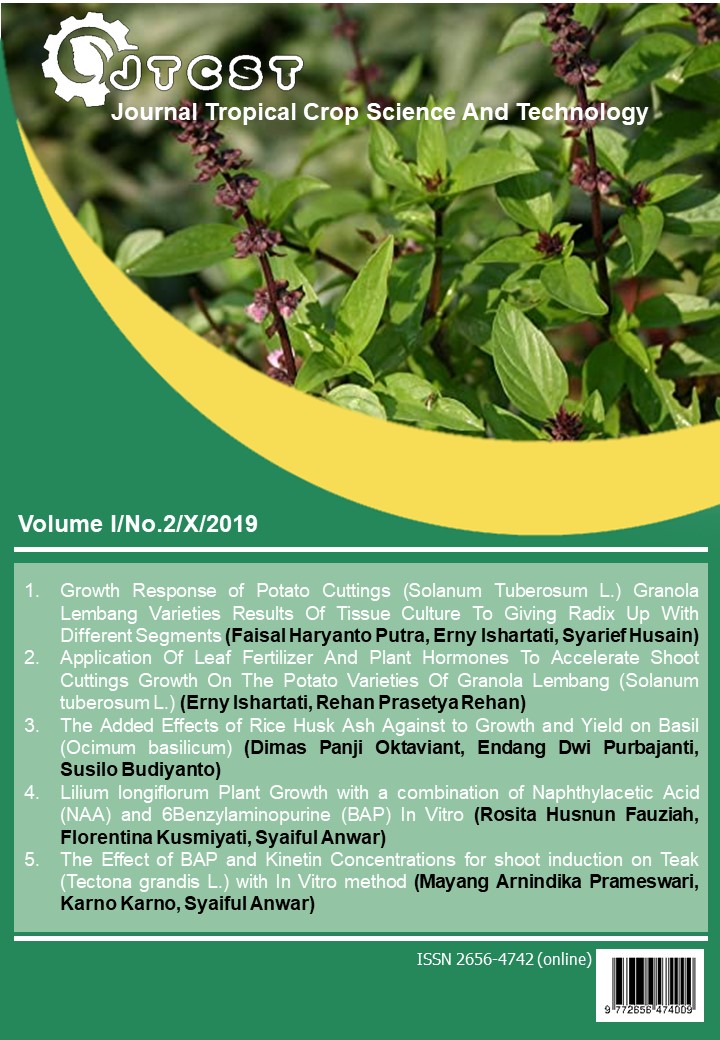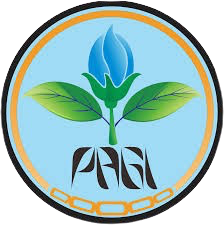The Added Effects of Rice Husk Ash Against to Growth and Yield on Basil (Ocimum basilicum)
DOI:
https://doi.org/10.22219/jtcst.v1i2.10383Keywords:
basil, cultivars, rice husk ashAbstract
Basil is a spice plant that is widely used as a culinary additive, fragrance, atractan, and anti-bacterial because it produces essential oils, basil oil. This research aimed to identifying the affect of adding rice husk ash on different basil’s cultivars on growth and yield of basil (Ocimum basilicum). This research use 4 x 2 factorial experiment pattern with Completely Randomized Design consisting of 5 replication. The first treatment was various type of basil’s cultivars such as Genovese cultivars (K1) and Dark Opal cultivars (K2). The second treatment was doses of rice husk ash such as control or without giving rice husk ash (M0), 30 g/pot (M1), 35 g/pot (M2), dan 40 g/pot (M3). The observed parameters were soil bulk density and porosity, plant height, leaves total, roots length, and leaves simplisia. The results showed that the application of husk ash can affect the increase in physical properties of the soil, but has not directly affected the growth parameters and yield of leaf simplisia. Dark Opal cultivars on all growth parameters showed higher yields, but Genovese cultivars showed higher yields or simplisia.Downloads
References
Aboutalebi, A., & Hosseinifarani, M. (2013). Evaluation of growth and yield of originicaly-grown basil (Ocimum basilicum) in soilless culture. Journal of Food Agricultural and Environment, 11(1) , 299–301.
Anindyawati, T. (2010). Potensi selulase dalam mendegradasi lignoselulosa limbah pertanian untuk pupuk organik. Berita Selulosa, 45(2), 70–77.
Daza-Torres, M. C., Arias-Prado, P. C., Reyes-Trujillo, A., & Urrutia-Cobo, N. (2017). Basil (Ocimum basilicum L.) water needs calculated from the crop coefficient. Journal Ingenieria e Investigacion, 37(3), 8–16.
Ekren, S., Sonmez, C., Ozcakal, E., Kurttas, E., Bayram, Y. S. K., & Gurgulu, H. (2012). The effect of different irrigation water levels in yield and quality characteristics of purple basil (Ocimum basilicum L.). Agricultural Water Management, 109, 155–161.
Fariudin, R., Sulistyaningsih, E., & Waluyo. E. (2013). Pertumbuhan dan hasil dua kultivar selada (Lactuca sativa L.) dalam akuaponika pada kolam gurami dan kolam nila. Jurnal Vegetalika, 2(1), 1–16.
Fitrianah, L., Fatimah, S., & Hidayati, Y. (2012). Pengaruh komposisi media tanam terhadap pertumbuhan dan kandungan saponin pada dua varietas tanaman gondola (Basella sp.). Jurnal Agrovigor, 5(1),34–47.
Gardner, J. A. (2014). Living with herbs. Vermont, US: The Countryman Press.
Hasanah, U. (2009). Respon tanaman tomat (Lycopersicum esculentum Mill) pada awal pertumbuhan terhadap keragaman ukuran agregat entisol. Jurnal Agroland, 16(2), 103–109.
Hutagalung, C. O. dan Maulida. (2014). Karakteristik fourier transform infra red dan kekuatan bentur komposit poliester tak jenuh berpengisi abu sekam padi putih. Jurnal Teknik Kimia USU, 3(1), 23–26.
Hutson, L. (2003). The herb garden cookbook. Austin, US: University of Texas Press.
Kiswondo, S. (2011). Penggunaan abu sekam dan pupuk ZA terhadap pertumbuhan dan hasil tanaman tomat (Lycopersicum esculentum Mill.). Jurnal Embryo, 8(1), 9–17.
Kurnia, U., Agus, F., Adimihardja, A., dan Dariah, A. (2006). Sifat fisik tanah dan metode analisisnya. Badan Penelitian dan Pengembangan Pertanian, Departemen Pertanian.
Pane, M. A., Damanik, M. M. B., dan Sitorus, B. (2014). Pemberian bahan organik kompos jerami padi dan abu sekam padi dalam memperbaiki sifat kimia tanah ultisol serta pertumbuhan tanaman jagung. e-J. Agroekoteknologi, 2(4), 1426–1432.
Rahmi, A. dan Biantary, M. P. (2014). Karakteristik sifat kimia tanah dan status kesuburan tanah lahan pekarangan dan lahan usaha tani beberapa kampung di Kabupaten Kutai Barat. J. Ziraa.ah, 39(1), 30–36.
Seipin, M., Sjofjan, J., dan Ariani, E. (2016). Pertumbuhan dan produksi tanaman jagung manis (Zea mays saccharata Sturt) pada lahan gambut yang diberi abu sekam padi dan trichokompos jerami padi. JOM Faperta, 3(2), 1–15.
Sutanto, R. (2002). Penerapan Pertanian Organik. Yogyakarta, Indonesia: Kanisius.
Tamtomo, F., Rahayu, S., dan Suyanto, A. (2015). Pengaruh aplikasi kompos jerami dan abu sekam padi terhadap produksi dan kadar pati ubijalar. Jurnal Agrosains, 12(2), 1–7.
Wahyuni, S., Hadipoentyanti, E., dan Kardinan, A. (2005). Karakteristik morfologi dan kandungan minyak dua nomor selasih hutan (Ocimum gratissimum L.). Buletin Tanaman Rempah dan Obat. 16(1), 10– 17.
Downloads
Published
How to Cite
Issue
Section
License
Copyright (c) 2019 Dimas Panji Oktaviant, Endang Dwi Purbajanti, Susilo Budiyanto

This work is licensed under a Creative Commons Attribution-ShareAlike 4.0 International License.
Authors who publish with this journal agree to the following terms:
- Authors retain copyright and grant the journal right of first publication with the work simultaneously licensed under a Creative Commons Attribution License that allows others to share the work with an acknowledgement of the work's authorship and initial publication in this journal.
- Authors are able to enter into separate, additional contractual arrangements for the non-exclusive distribution of the journal's published version of the work (e.g., post it to an institutional repository or publish it in a book), with an acknowledgement of its initial publication in this journal.
- Authors are permitted and encouraged to post their work online (e.g., in institutional repositories or on their website) prior to and during the submission process, as it can lead to productive exchanges, as well as earlier and greater citation of published work (See The Effect of Open Access).











